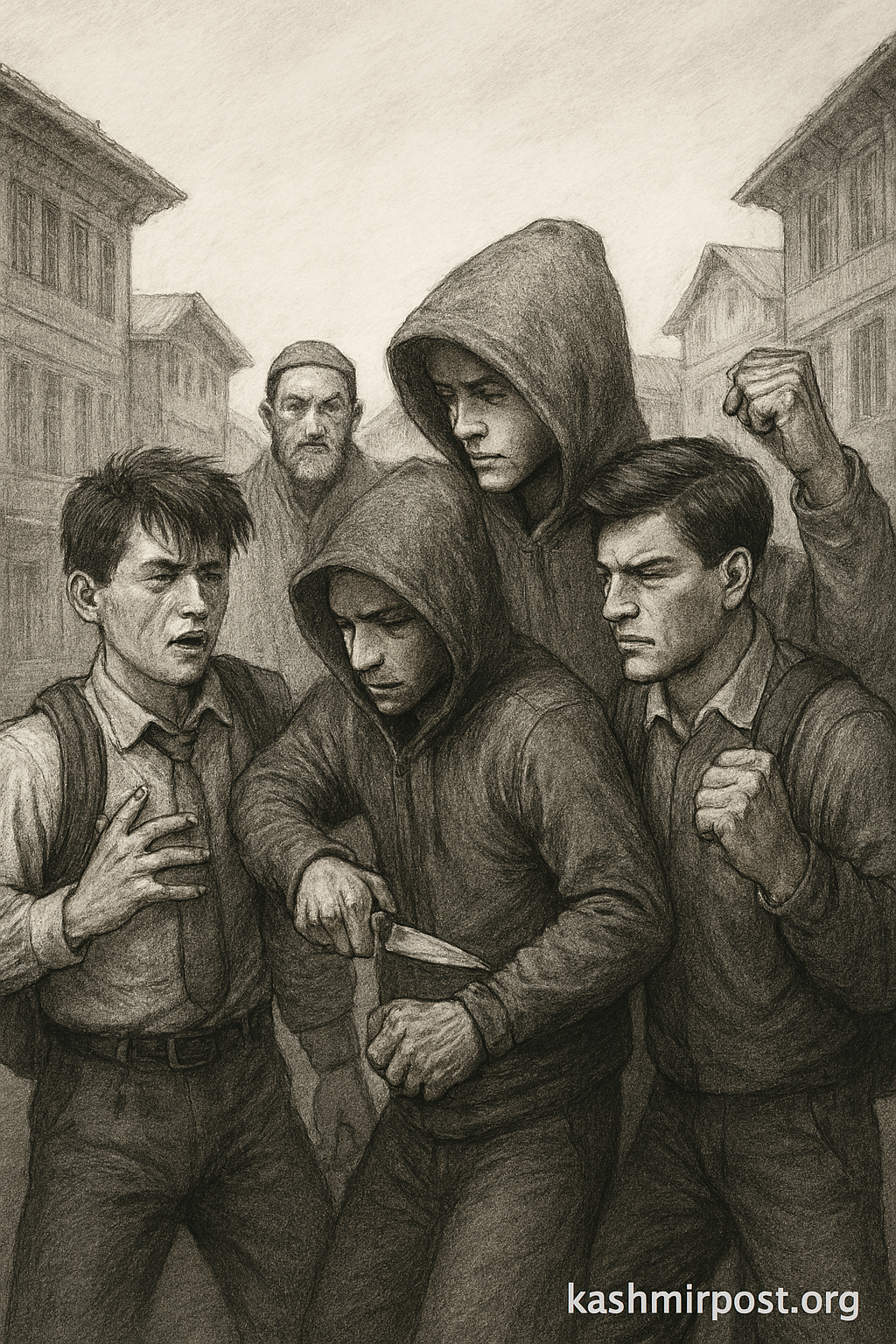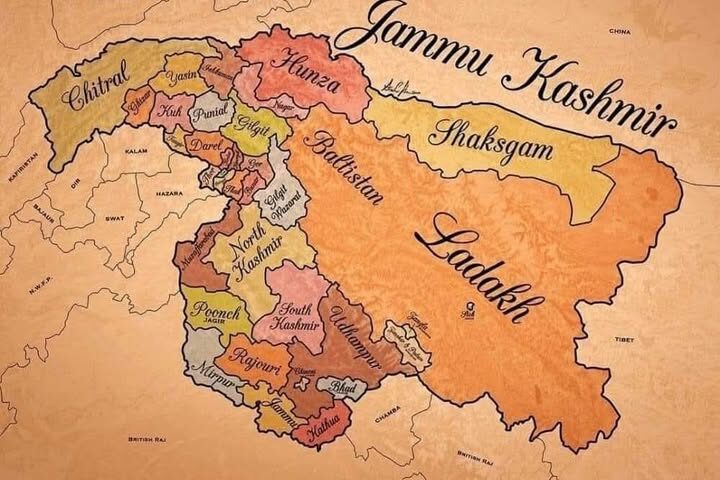Rebels in Uniform: Kashmir’s Knife-Wielding Children & the Descent Into Gang Warfare
By: Javid Amin | Srinagar | 08 Aug 2025
When Textbooks Are Traded for Blades
Srinagar. The name once conjured images of serene Dal Lake, majestic chinars, and a rich tapestry of culture and learning. Today, a chilling new reality echoes through its ancient alleys and modern thoroughfares: the sound of sirens responding to teen-on-teen violence, the hushed whispers of gang rivalries, and the heart-wrenching cries of parents whose children have swapped school uniforms for the grim insignia of street gangs. We are witnessing an unprecedented and deeply disturbing phenomenon: children, some barely into their teens, embroiled in brutal stabbings and organized gang warfare. This isn’t random delinquency; it’s a systemic societal hemorrhage demanding urgent, unflinching attention. The valley isn’t just facing a law and order issue; it’s staring into an abyss of generational trauma. Why are our classrooms breeding rebels? Why has the knife become a symbol of power for our youth? This is the story of Srinagar’s lost children, a crisis threatening to consume its very future.
Blood on the Playground – The Epidemic of Youth Stabbings
The casual brutality and frequency of knife attacks involving minors have shattered any illusion of safety. This isn’t isolated; it’s a grim, escalating pattern:
-
SP College Playground, October 2024: Romance Turned Deadly: What began as a youthful romantic dispute escalated into a scene of horror. A Swiggy delivery rider, barely an adult himself, confronted a 23-year-old near the iconic college grounds. Witnesses described a sudden, frenzied attack. The victim, unarmed and unprepared, succumbed to multiple stab wounds. The chilling takeaway? The perpetrator wasn’t a hardened criminal but a young man navigating the gig economy, his rage fueled by perceived slights, culminating in lethal violence in a space meant for learning and leisure. It signaled that violence wasn’t confined to shadows but had invaded the heart of educational institutions.
-
Zero Bridge, June 2025: Daylight Brutality & Public Outrage: The broad daylight stabbing of 18-year-old Imran Bilal Shah sent seismic waves through the city. This wasn’t a hidden alley crime; it was brazen, witnessed by commuters on a major city artery. Shah, a young man with his life ahead of him, was attacked with shocking savagery. The public outrage was immediate and visceral – protests erupted, demanding answers and action. This incident starkly illustrated how normalized such violence had become, emboldening perpetrators to act with impunity even in the busiest hours. It became a symbol of the city’s collective fear and failing systems.
-
Government Polytechnic College, Bemina, August 2023: Petty Conflict, Permanent Consequence: A seemingly trivial disagreement between students spiraled out of control with terrifying speed. Two teenagers, their anger unchecked, attacked a 19-year-old classmate. The altercation, likely over something minor, ended with the victim bleeding on campus grounds. This incident is particularly alarming as it highlights the extreme volatility among youth, where minor conflicts trigger disproportionate, life-threatening responses, blurring the lines between schoolyard fights and criminal assault within educational walls.
-
Dalgate, September 2023: A Child Kills a Child – The Unthinkable Tragedy: Perhaps the most soul-crushing incident. A 15-year-old boy, his adolescence barely begun, fatally stabbed another juvenile. The sheer youth of both victim and perpetrator sent shockwaves of disbelief and profound grief across Srinagar. It forced the community to confront an unbearable truth: the violence wasn’t just among youth; it was being perpetrated by children against children. The innocence of childhood was irrevocably shattered. This tragedy exposed the depth of the crisis, reaching down into early adolescence.
-
The Futility of the Ban: Despite a district-wide ban on carrying sharp-edged weapons, the blades continue to flash. This underscores a critical failure: legislation alone is impotent against the deep-seated social, psychological, and economic drivers pushing youth towards violence. The knives are symptoms, not the root cause. Enforcement is challenging, and the allure of the weapon as a symbol of power and protection within gang dynamics overrides legal deterrents for these desperate or desensitized teens.
Gangs of Srinagar – Identity Forged in Steel and Secrecy
Gang culture isn’t an import; it’s a homegrown malignancy metastasizing in Srinagar’s vulnerable neighborhoods, particularly the historic downtown areas. This is not mere teenage mischief; it’s organized, hierarchical, and terrifyingly violent.
-
The Gruesome Rivalry: 16 Gujjar Gang vs. Downtown Itehad: The killing of Mehran Ali Sheikh, a gym trainer and alleged ringleader of the “Downtown Itehad” gang, in Nawakadal in early 2025, laid bare the lethal reality of these affiliations. Sheikh was reportedly gunned down in a retaliatory attack linked to an ongoing feud with the rival “16 Gujjar Gang.” This wasn’t a random act; it was a calculated hit in a turf war fought by teenagers and young adults. The involvement of a fitness professional as a leader underscores how these groups recruit across social strata, offering a perverse sense of purpose and belonging.
-
The Mechanics of Modern Gangs: Forget spray paint and street corners. Today’s Srinagar gangs operate with alarming sophistication:
-
Coded Identities: Members adopt aliases, specific colors, hand signs, and even distinct linguistic codes to signify allegiance and intimidate rivals.
-
Encrypted Battlefields: Communication and coordination happen on encrypted messaging apps (Signal, Telegram, WhatsApp groups with disappearing messages), making detection incredibly difficult for authorities and parents alike. Threats are issued, meet-ups arranged, and violence glorified within these digital shadows.
-
Twisted Loyalty & Initiation: Loyalty to the gang is paramount, often enforced through violent initiation rituals or demands to participate in attacks. Betrayal is met with extreme retribution, trapping members in a cycle of fear and violence. The gang becomes a substitute family, offering a distorted sense of protection and identity absent elsewhere.
-
Student Soldiers: The most chilling aspect? The rank-and-file members are predominantly students. They attend local schools and colleges by day, carrying the weight of textbooks and gang rivalries simultaneously. The classroom becomes a recruitment ground and a place to project power or identify targets.
-
Unraveling the Why – The Toxic Cocktail Breeding Rebellion
To dismiss this as simple “bad behavior” is dangerously naive. This rebellion is rooted in a complex, toxic brew of societal failures:
-
The Crushing Weight of Hopelessness: Unemployment’s Vicious Grip: Jammu & Kashmir’s youth unemployment rate, hovering around a staggering 32% (double the national average), is a suffocating reality. Imagine graduating high school or college with ambition, only to face a brick wall of “no opportunities.” Years of conflict, political instability, and economic stagnation have decimated the job market. The pervasive feeling is, “What future? Why strive?” This vacuum of hope creates fertile ground for frustration, anger, and nihilism. Crime, especially the immediate power and perceived “income” (however illicit) offered by gang association, becomes a tragically logical alternative to a life of perceived uselessness. The promise of quick money through extortion or theft is a siren call to the desperate.
-
The Digital Distortion Field: Glorifying Violence, One Like at a Time: Social media isn’t just a platform; for many teens, it’s a parallel universe where identity is forged. And in Srinagar’s digital underbelly, violence is currency. Teens post videos flaunting knives, issuing chilling threats to rival gangs, and documenting acts of bravado (real or staged). The likes, shares, and comments become a powerful form of peer validation. This digital glorification creates a dangerous feedback loop: online notoriety fuels real-world violence, which is then captured and amplified online for more validation. Algorithms push extreme content, exposing impressionable minds to a normalized world of aggression and conflict resolution through force. The line between virtual posturing and real-life stabbing blurs catastrophically.
-
The Fractured Safety Net: Parental Disconnect & Community Erosion: The traditional support structures are crumbling. Many parents, grappling with their own economic hardships, trauma from decades of conflict, or simply the demands of survival, are tragically disconnected from their children’s inner worlds. The “double life” – respectful student at home, gang member or violent actor outside – thrives in this gap. Furthermore, the extended family and close-knit community structures that once provided oversight and moral guidance have eroded due to urbanization, migration, and the pervasive atmosphere of fear and mistrust. Children are navigating treacherous waters without compass or anchor.
-
The Numbing Escape & Fueled Rage: Drug Abuse & Mental Health Desolation: The statistics are horrifying: over 67,000 registered drug addicts in the Valley, with an estimated 85% hooked on heroin, often consumed multiple times daily. This isn’t just a separate crisis; it’s intrinsically linked to youth violence. Substance abuse:
-
Fuels Impulsivity: Drugs like heroin and prescription opioids lower inhibitions and impair judgment, making violent outbursts over minor slights far more likely.
-
Funds the Gangs: Addiction creates a desperate need for cash, driving youth into petty crime or deeper gang involvement (dealing, theft, extortion) to feed their habit.
-
Masks Unbearable Pain: For many, drugs are a form of self-medication for untreated trauma, depression, anxiety, and the overwhelming stress of their environment. The underlying mental health crisis is colossal, exacerbated by stigma and a severe lack of accessible, affordable, and culturally sensitive mental health services. Violence becomes an external manifestation of deep internal suffering.
-
Normalizing the Unthinkable? This is a Code Red Societal Emergency
Let’s be unequivocal: This is NOT normal. The sight of schoolchildren carrying knives, the emergence of violent teen gangs claiming territories, the fatal stabbings by minors – these are not rites of passage. They are glaring, flashing red lights on the dashboard of our society, signaling a catastrophic system failure.
-
Beyond Delinquency: This transcends typical teenage rebellion or petty crime. It’s the weaponization of childhood and adolescence. The normalization of lethal violence as a means of conflict resolution or status acquisition among those who should be focused on exams and friendships is a profound psychological and societal breakdown.
-
The Warning Sign Ignored is a Crisis Embraced: Every incident, every young life lost or ruined, is a warning we have collectively failed to heed. The question isn’t merely “Why are our kids rebelling?” It’s far more damning: “Who is failing them?” The answer points to multiple fronts: fractured families, an education system ill-equipped for socio-emotional needs, a collapsed economy, inadequate mental health support, ineffective policing strategies, and a political environment offering little tangible hope.
-
The Generational Cost: The true cost is measured in lost potential, perpetuated trauma, and a future shaped by fear and division. Children exposed to or participating in such violence carry deep psychological scars that impact their ability to form healthy relationships, hold stable jobs, and contribute positively to society. It risks creating a lost generation, further destabilizing an already fragile region.
Planned Destruction or Systemic Collapse?
The anguished question “Is this a planned process to destroy our generation?” resonates deeply in a region scarred by conflict and distrust. While external malign influences seeking to destabilize cannot be entirely discounted, attributing this complex crisis solely to a shadowy conspiracy is an oversimplification that risks absolving local responsibility.
-
The More Insidious Reality: Systemic Neglect: The primary driver is a catastrophic failure of systems meant to nurture and protect youth. It’s the culmination of:
-
Chronic Underinvestment: In education (beyond rote learning), youth programs, job creation, and mental healthcare.
-
Institutional Apathy: Slow, often insensitive bureaucratic responses to escalating warning signs.
-
Social Fragmentation: The breakdown of community bonds and traditional support mechanisms.
-
Normalization of Violence: Decades of conflict have inevitably desensitized some segments of society to violence, subtly lowering thresholds for its acceptance among youth.
-
-
Outcome Over Intent: Whether by design or disastrous neglect, the outcome is tragically identical: a generation adrift, traumatized, and lashing out, its potential squandered. Focusing solely on conspiracy can paralyze local action. Acknowledging systemic failures empowers the community to demand accountability and drive change.
Reclaiming the Future – A Multi-Pronged Battle Plan
There are no quick fixes, but surrender is not an option. Combating this crisis requires a sustained, holistic, and compassionate “whole-of-society” approach:
-
Beyond Policing: Community Guardianship & Mentorship:
-
Restorative Justice Hubs: Shift focus from purely punitive measures to community-led restorative justice programs involving elders, respected figures, and victim-offender mediation, fostering accountability and healing.
-
Trust-Building Policing: Establish dedicated, trained Youth Liaison Officers focused on building rapport with teens in schools and communities, acting as preventers rather than just enforcers. Implement community policing models where officers are known and accessible figures.
-
Robust Mentorship Networks: Create large-scale programs pairing vulnerable youth with positive adult role models from diverse professions – business owners, artists, engineers, athletes – providing guidance, exposure to alternatives, and a stable support figure.
-
-
Transforming Schools: Fortresses of Well-being, Not Fear:
-
Mandatory Socio-Emotional Learning (SEL): Integrate comprehensive SEL curricula from primary levels upwards, teaching self-awareness, emotional regulation, empathy, conflict resolution, and responsible decision-making. Make it as core as math or science.
-
Safe Spaces & Trained Counselors: Ensure every school has accessible, confidential counseling services staffed by trained professionals. Create designated “safe zones” where students feel secure reporting threats or seeking help without stigma.
-
Anti-Violence & Anti-Gang Education: Develop specific modules debunking gang myths, illustrating the devastating consequences of violence and knife crime, and teaching positive identity formation and resistance strategies to peer pressure.
-
Engaging Alternatives: Drastically expand after-school programs – sports leagues, arts workshops (music, theater, visual arts), coding clubs, debate societies – providing structure, purpose, and positive peer interaction.
-
-
Taming the Digital Beast: Responsibility & Positive Narrative:
-
Platform Accountability: Advocate for and enforce stricter content moderation by social media platforms operating in the region, swiftly removing violent threats, glorification of gangs/weapons, and harmful challenges. Collaborate with tech companies.
-
Digital Literacy Crusade: Teach youth (and parents) critical thinking online, identifying harmful content, understanding privacy settings, and recognizing digital manipulation. Schools and community centers must lead this.
-
Amplifying the Positive: Launch aggressive social media campaigns showcasing positive youth role models, success stories, creative pursuits, and peaceful community initiatives. Flood the digital space with counter-narratives of hope and achievement.
-
-
Igniting Hope: Pathways to Dignity through Work:
-
Massive Skill Mission: Launch government and private sector-backed intensive skilling programs aligned with market demands (IT, tourism, handicrafts revival, green energy, agriculture tech). Focus on employability and certifications.
-
Youth Entrepreneurship Incubators: Provide seed funding, low-interest loans, mentorship, and workspace for viable youth-led startup ideas, fostering self-reliance and innovation.
-
Public Works & Apprenticeships: Create large-scale public works projects (infrastructure, environmental restoration) with reserved youth quotas. Mandate apprenticeships in industries receiving government support.
-
-
Healing the Invisible Wounds: Mental Health for All:
-
De-stigmatization Campaigns: Use local media, religious leaders, and community influencers to openly discuss mental health, challenge stigma, and promote seeking help as a sign of strength.
-
Accessible Care Infrastructure: Invest heavily in training and deploying clinical psychologists, counselors, and psychiatric social workers. Establish well-equipped, affordable mental health clinics at the district and sub-district levels. Integrate basic mental health screening into schools and primary health centers.
-
Trauma-Informed Support: Train teachers, police officers, social workers, and community leaders in recognizing and responding supportively to trauma, which is endemic in the Kashmiri experience.
-
-
Rebuilding the Village: Family & Community Resilience:
-
Parenting Support Programs: Offer accessible workshops and resources for parents on effective communication, recognizing warning signs of gang involvement or distress, setting boundaries, and navigating the digital world with their children.
-
Reviving Community Spaces: Invest in revitalizing parks, community centers, and libraries as safe, vibrant hubs for positive intergenerational interaction and activities.
-
Inter-Faith & Cross-Community Dialogues: Foster initiatives bringing diverse community and religious leaders together to promote shared values of peace, non-violence, and collective responsibility for youth well-being.
-
Bottom-Line: The Stakes Could Not Be Higher
Srinagar stands at a precipice. The image of a child wielding a knife against another child is not just a crime scene; it’s the portrait of a future slipping away. The rise of teen gangs and the normalization of violence among schoolchildren is not a phase; it’s a five-alarm fire consuming the very foundations of society.
The solutions outlined are not mere suggestions; they are the essential scaffolding for rebuilding. This demands unprecedented political will, substantial financial investment, and, above all, a collective societal awakening. Parents must look beyond the surface. Educators must become guardians of well-being as much as knowledge. Policymakers must prioritize youth not as statistics, but as the valley’s most precious resource. Communities must reclaim their streets and their children.
The rebellion in uniform is a desperate, distorted cry for belonging, purpose, and hope. Answering that cry with empathy, opportunity, and unwavering commitment isn’t just an option; it’s the only path to salvaging Kashmir’s soul. The time for hand-wringing is over. The time for courageous, concerted action is now. Our children’s future, and Srinagar’s very essence, depend on it.



